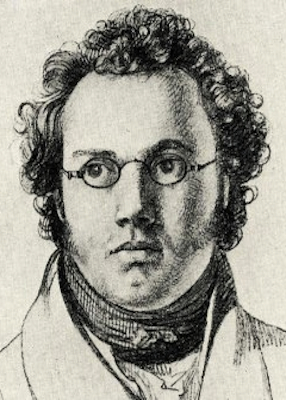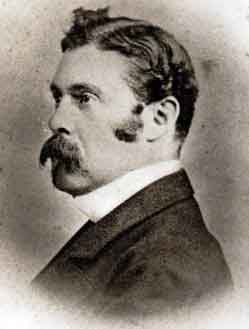
The Trout Quintet (Forellenquintett) is the popular name for the Piano Quintet in A major, D. 667, by Franz Schubert. The piano quintet was composed in 1819, when he was 22 years old; it was not published, however, until 1829, a year after his death.
The Piano Quintet in F minor, Op. 34, by Johannes Brahms was completed during the summer of 1864 and published in 1865. It was dedicated to Her Royal Highness Princess Anna of Hesse. As with most piano quintets composed after Robert Schumann's Piano Quintet (1842), it is written for piano and string quartet.

Ludwig van Beethoven's Piano Sonata No. 29 in B♭ major, Op. 106 is a piano sonata that is widely viewed as one of the most important works of the composer's third period and among the greatest piano sonatas of all time. Completed in 1818, it is often considered to be Beethoven's most technically challenging piano composition and one of the most demanding solo works in the classical piano repertoire. The first documented public performance was in 1836 by Franz Liszt in the Salle Erard in Paris to an enthusiastic review by Hector Berlioz.

The Cello Sonata No. 1 in E minor, Op. 38, entitled "Sonate für Klavier und Violoncello", was written by Johannes Brahms in 1862–65.

Franz Schubert's Symphony No. 8 in B minor, D. 759, commonly known as the Unfinished Symphony, is a musical composition that Schubert started in 1822 but left with only two movements—though he lived for another six years. A scherzo, nearly completed in piano score but with only two pages orchestrated, also survives.

Franz Schubert's final chamber work, the String Quintet in C major is sometimes called the "Cello Quintet" because it is scored for a standard string quartet plus an extra cello instead of the extra viola which is more usual in conventional string quintets. It was composed in 1828 and completed just two months before the composer's death. The first public performance of the piece did not occur until 1850, and publication occurred three years later in 1853. Schubert's only full-fledged string quintet, it has been praised as "sublime" or "extraordinary" and as possessing "bottomless pathos," and is generally regarded as Schubert's finest chamber work as well as one of the greatest compositions in all chamber music.
Franz Liszt wrote drafts for his Concerto for Piano and Orchestra No. 2 in A major, S.125, during his virtuoso period, in 1839 to 1840. He then put away the manuscript for a decade. When he returned to the concerto, he revised and scrutinized it repeatedly. The fourth and final period of revision ended in 1861. Liszt dedicated the work to his student Hans von Bronsart, who gave the first performance, with Liszt conducting, in Weimar on January 7, 1857.
The Fantasie in C major, Op. 15, popularly known as the Wanderer Fantasy, is a four-movement fantasy for solo piano composed by Franz Schubert in 1822. It is widely considered Schubert's most technically demanding composition for the piano. Schubert himself said "the devil may play it," in reference to his own inability to do so properly.

Franz Schubert wrote his Sonata in C major for piano four-hands, D 812, in June 1824 during his second stay at the Esterházy estate in Želiezovce. The extended work, in four movements, has a performance time of around 40 to 45 minutes. It was published as Grand Duo, Op. 140, in 1837, nine years after the composer's death.
Symphony No. 7 is the name given to a four-movement symphony in E major drafted by Franz Schubert in August 1821. Although the work is structurally complete, Schubert only orchestrated the slow introduction and the first 110 bars of the first movement. The rest of the work is continued on 14-stave score pages as a melodic line with occasional basses or counterpoints, giving clues as to changes in orchestral texture.

Schubert's Symphony No. 10 in D major, D 936A, is an unfinished work that survives in a piano sketch. Written during the last weeks of the composer's short life, it was only properly identified in the 1970s. It has been orchestrated by Brian Newbould in a completion that has subsequently been performed, published and recorded.
Franz Schubert's Piano Sonata in A minor, D 784, is one of Schubert's major compositions for the piano. Schubert composed the work in February 1823, perhaps as a response to his illness the year before. It was however not published until 1839, eleven years after his death. It was given the opus number 143 and a dedication to Felix Mendelssohn by its publishers. The D 784 sonata, Schubert's last to be in three movements, is seen by many to herald a new era in Schubert's output for the piano, and to be a profound and sometimes almost obsessively tragic work.
The Piano Sonata in F-sharp minor D 571, was composed by Franz Schubert in July 1817. The sonata was first published long after the composer's death in 1888 by Breitkopf & Härtel.

Franz Schubert's last three piano sonatas, D 958, 959 and 960, are his last major compositions for solo piano. They were written during the last months of his life, between the spring and autumn of 1828, but were not published until about ten years after his death, in 1838–39. Like the rest of Schubert's piano sonatas, they were mostly neglected in the 19th century. By the late 20th century, however, public and critical opinion had changed, and these sonatas are now considered among the most important of the composer's mature masterpieces. They are part of the core piano repertoire, appearing regularly on concert programs and recordings.
The Piano Sonata No. 2 in F♯ minor, Op. 2 of Johannes Brahms was written in Hamburg, Germany in 1852, and published the year after. Despite being his second published work, it was actually composed before his Piano Sonata No. 1 in C major, but was published later because Brahms recognized the importance of an inaugural publication and felt that the C major sonata was of higher quality. It was sent along with his first sonata to Breitkopf und Härtel with a letter of recommendation from Robert Schumann. Schumann had already praised Brahms enthusiastically, and the sonata shows signs of an effort to impress, with its technical demands and highly dramatic nature. It was dedicated to Clara Schumann.

Marie-Alexis de Castillon de Saint-Victor was a French composer.

The Piano Trio No. 1 in B major, Op. 8, by Johannes Brahms was completed in January 1854, when the composer was only twenty years old, published in November 1854 and premiered on 13 October 1855 in Danzig. It has often been mistakenly claimed that the first performance had taken place in the United States. Brahms produced a revised version of the work in summer 1889 that shows significant alterations so that it may even be regarded as a distinct (fourth) piano trio. This "New Edition", as he called it, was premiered on 10 January 1890 in Budapest and published in February 1891.
Brian Newbould is an English composer, conductor and author who has conjecturally completed Franz Schubert's Symphonies D 708A in D major, No. 7 in E major, No. 8 in B minor ("Unfinished"), No. 10 ("Last") in D major, Piano Sonata in C major, D 840, Quartettsatz, D. 703 and String Trio, D. 471. He was educated at Gravesend Grammar School, and earned a BMus degree with top honors from the University of Bristol.

Schubert's Symphony in D major, D 708A, is an unfinished work that survives in an incomplete eleven-page sketch written for piano solo. It is one of Schubert's six unfinished symphonies. It was begun in 1820 or 1821, with initial sketches made for the opening sections of the first, second, and fourth movements, and an almost complete sketch for the third movement. He abandoned this symphony after this initial phase of work and never returned to it, although Schubert would live for another seven years. British conductor and composer Brian Newbould, an authority on Schubert's music, has speculated that the symphony was left incomplete due to problems Schubert faced in orchestrating the sketch.
Sonatas, duos and fantasies by Franz Schubert include all works for solo piano by Franz Schubert, except separate dances. They also include a number of works for two players: piano four hands, or piano and a string instrument.












